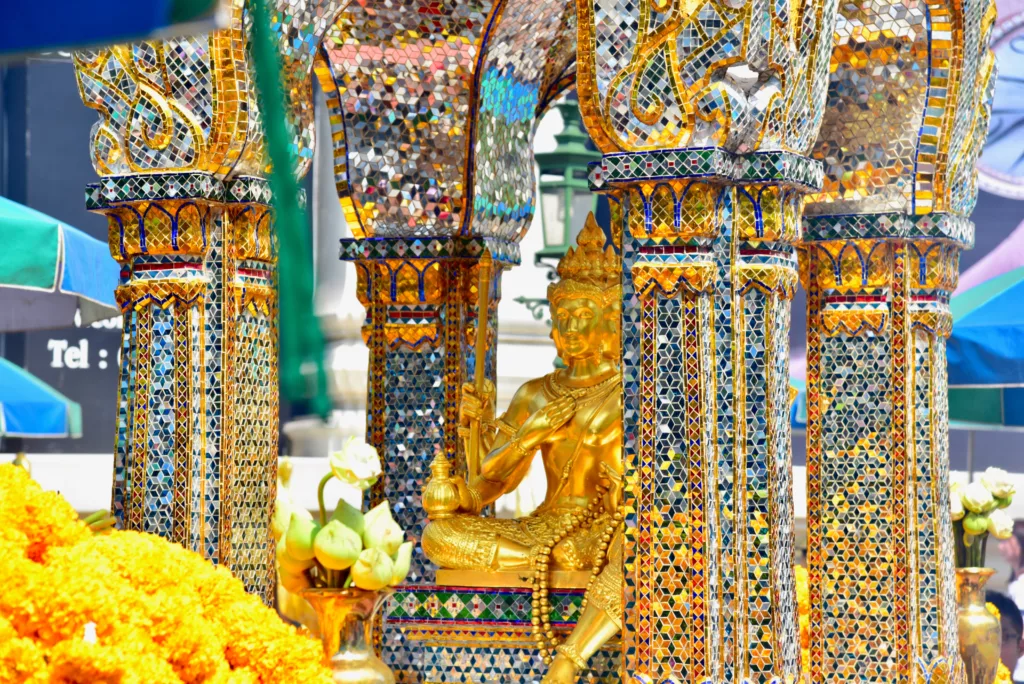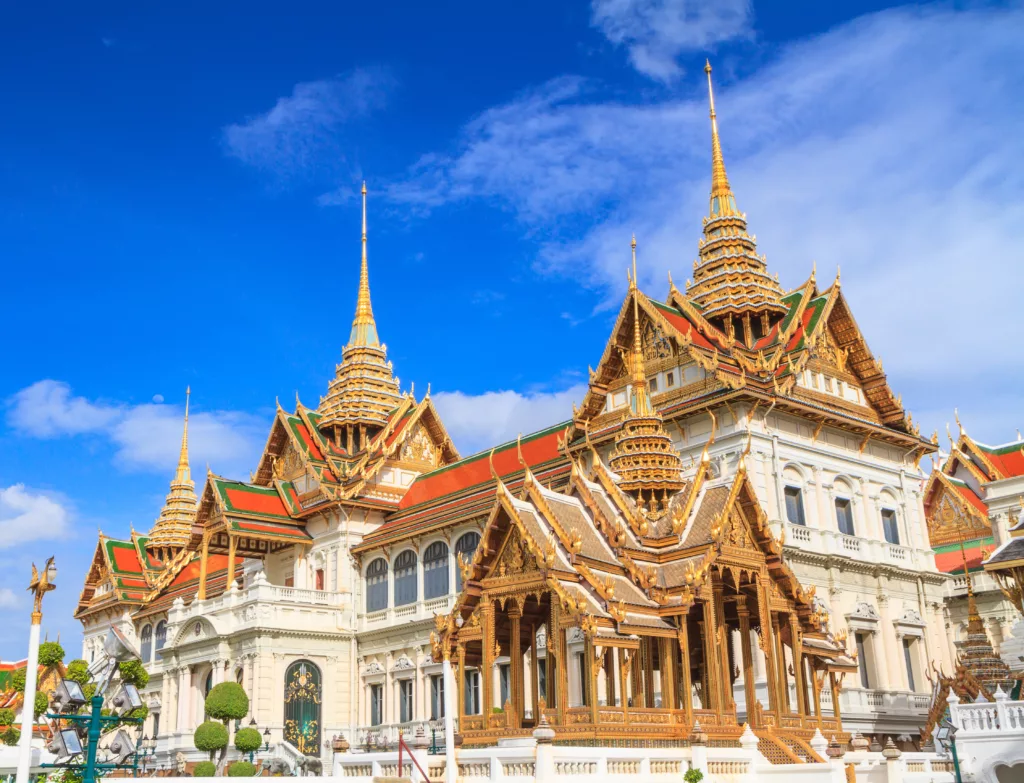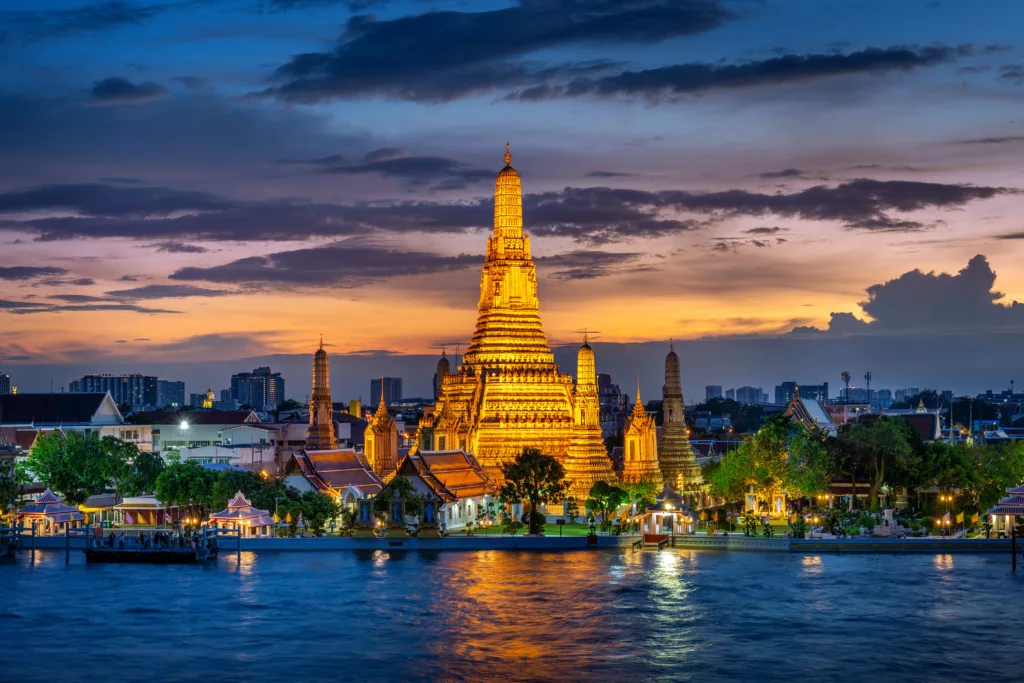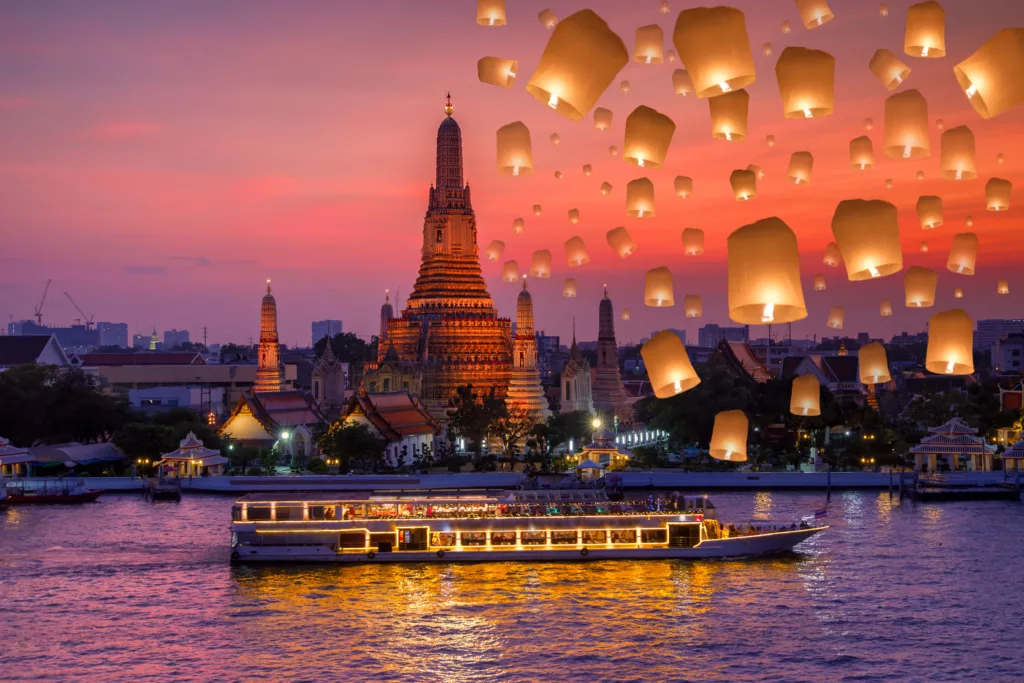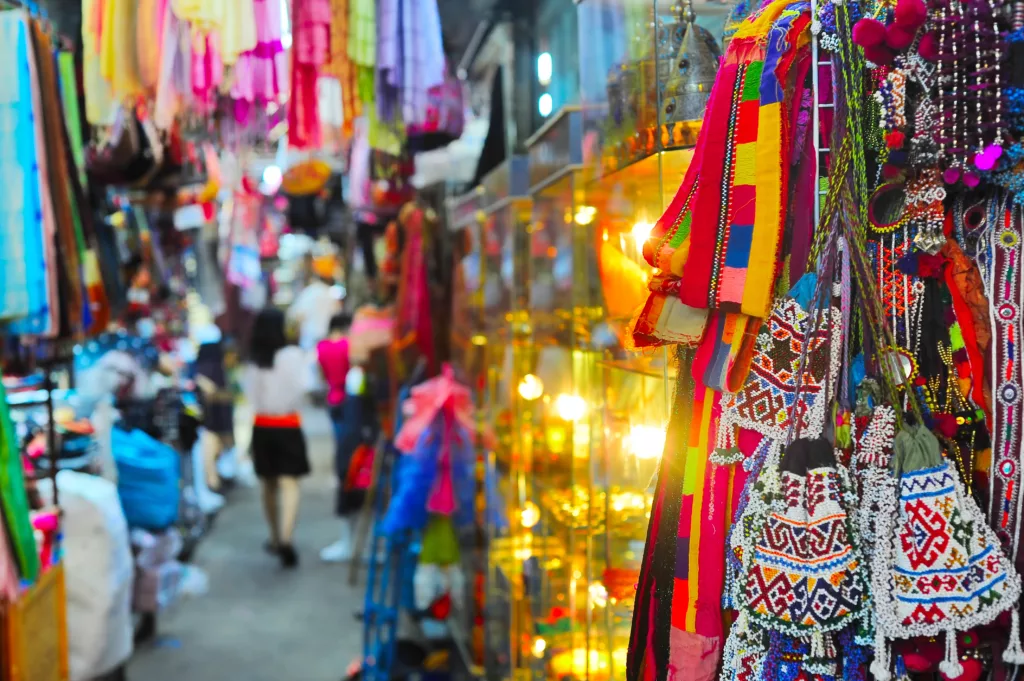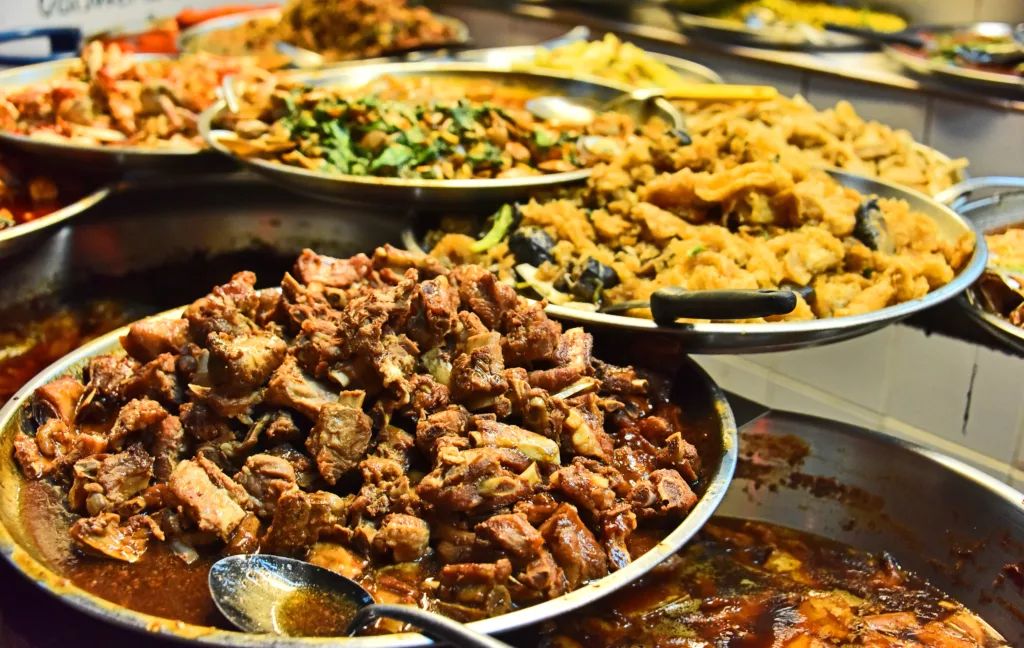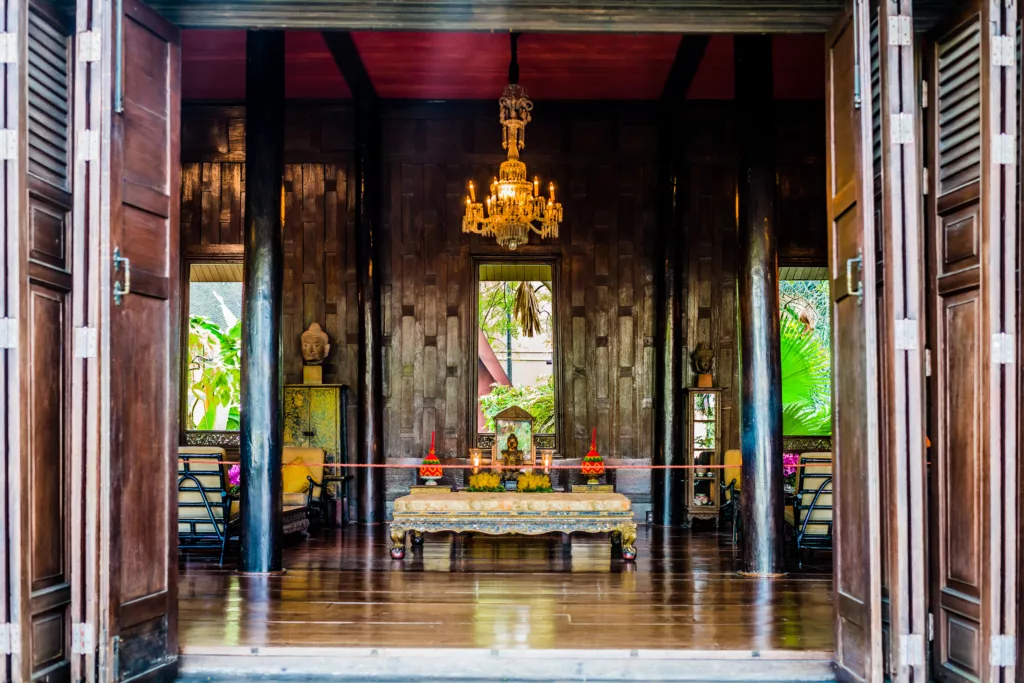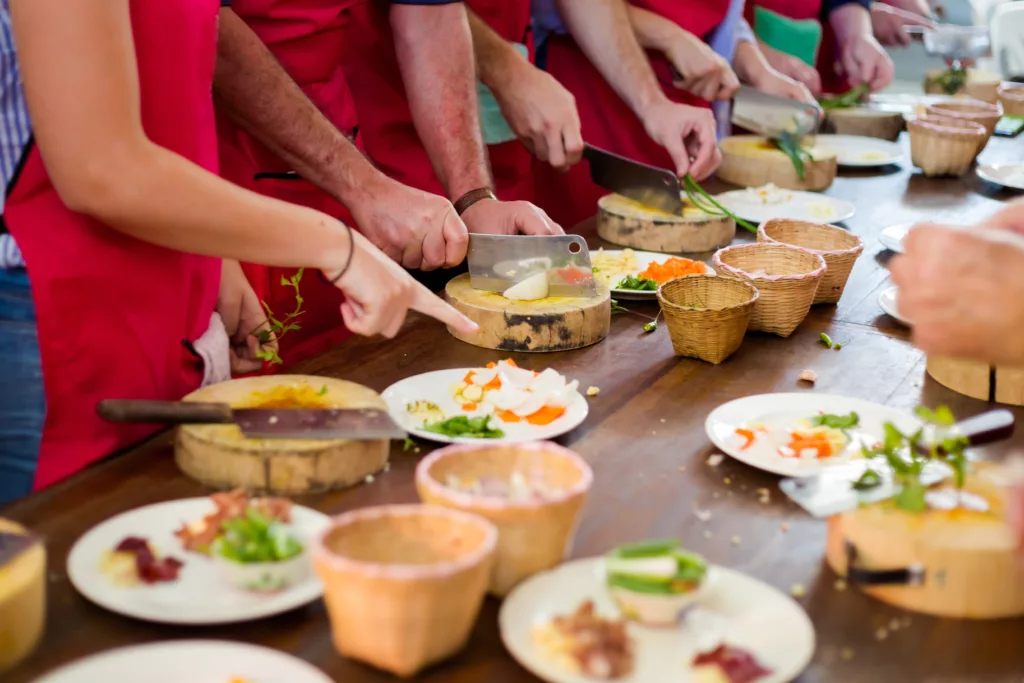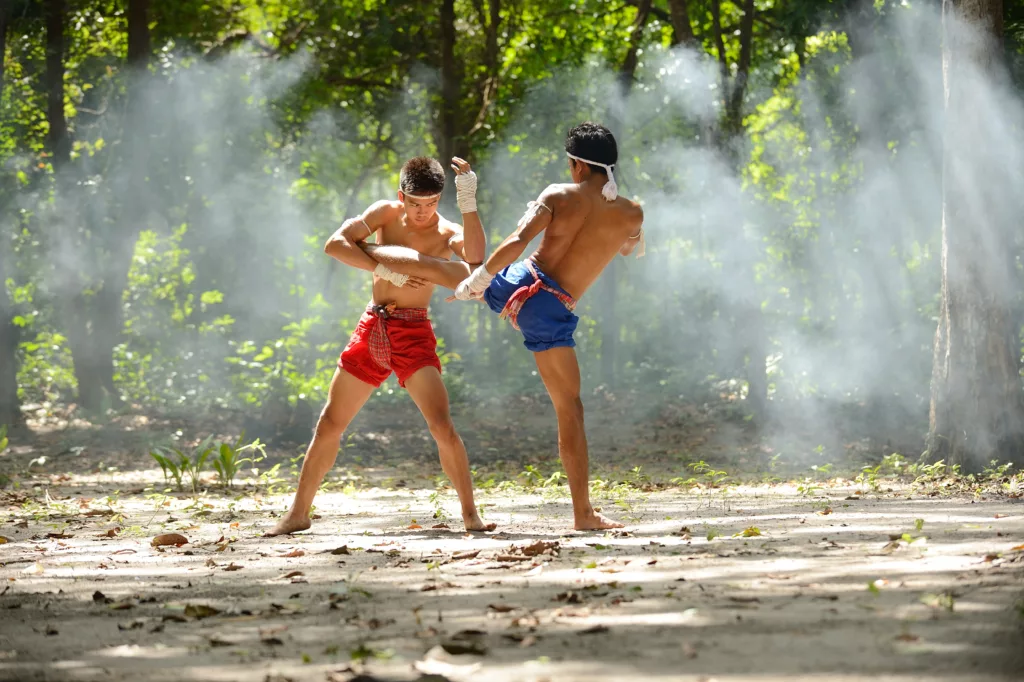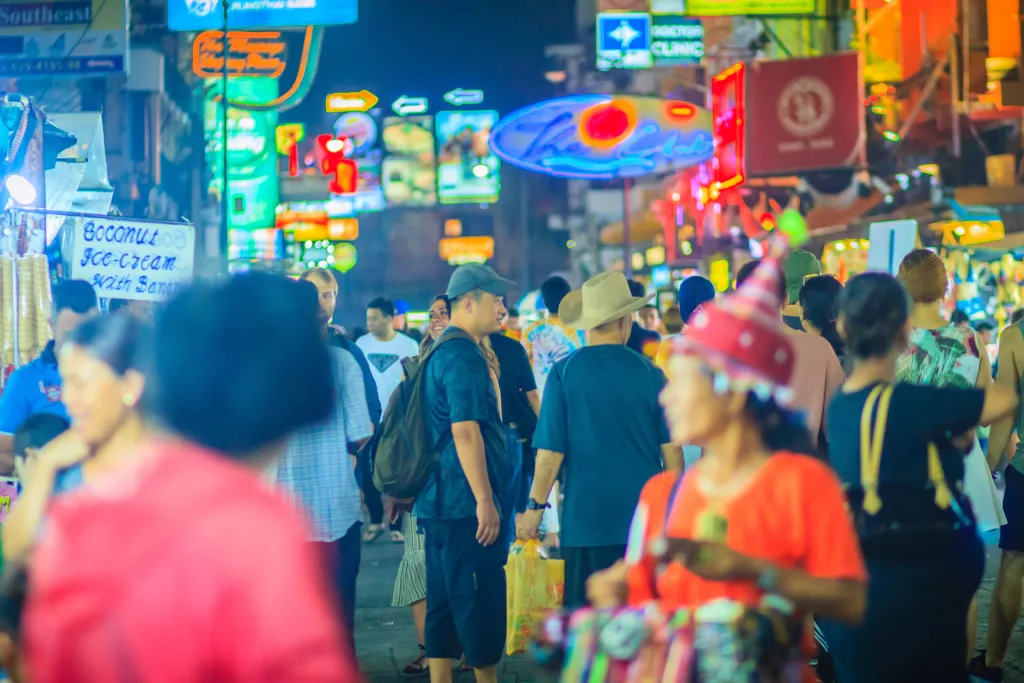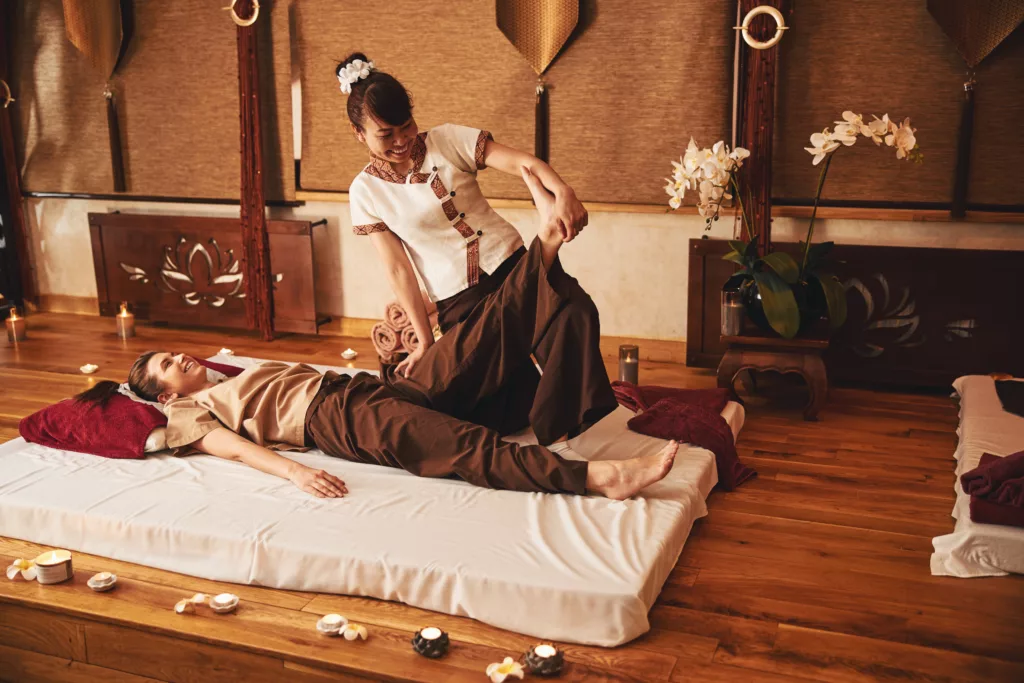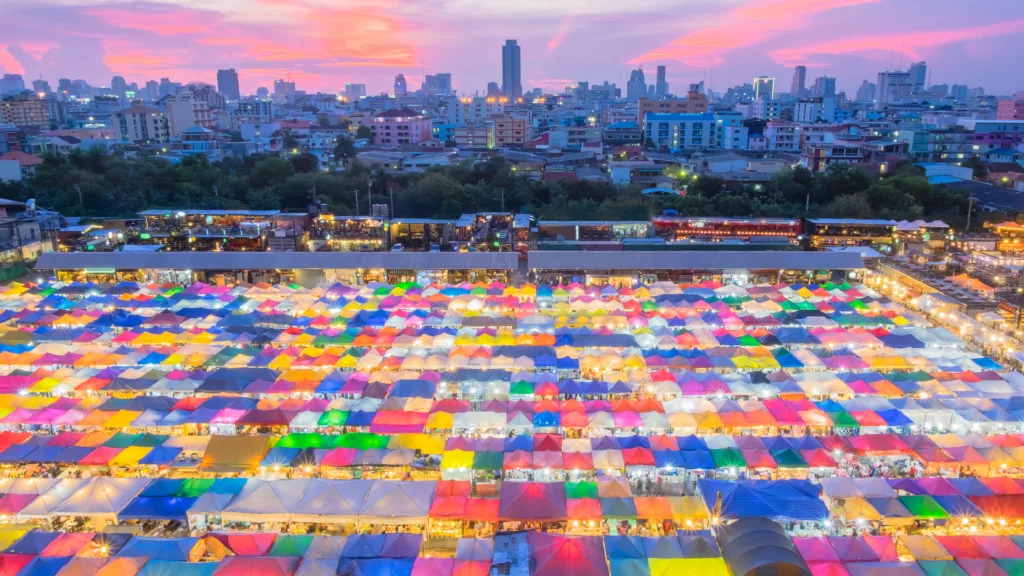Imagine being in a city where every corner holds a new adventure, a place where centuries-old traditions blend seamlessly with modern innovations. A city that offers an immersive sensory experience – from the smell of flavorful street foods to the sound of bustling markets, and the sight of glistening temples. Welcome to Bangkok, a city that is as diverse as it is captivating, as traditional as it is modern. It is a city that never fails to enchant those who tread its vibrant streets and beyond.
As you prepare for your journey, you might wonder about the multitude of experiences this mesmerizing city has to offer. With so many sights to see and activities to participate in, planning your itinerary can be quite daunting. But fear not, for we at Voyagix have put together an exclusive guide, thoughtfully curated to ensure you get the very best out of your Bangkok adventure. This guide reveals 15 unforgettable things to do in Bangkok that will captivate you and leave you yearning for more. From grand palaces and towering temples to bustling markets and delectable street food, there’s something in store for everyone. Whether you’re an adventurer at heart, a food lover, a history buff, or someone simply looking to immerse themselves in a new culture, our guide has got you covered. So buckle up and let’s dive into the wonder that is Bangkok!
1. Visit the Grand Palace
When you think of Bangkok, the iconic image of the Grand Palace likely comes to mind, and rightfully so. No trip to Bangkok would be complete without a visit to this historic and opulent complex. Serving as the official residence of the Kings of Thailand since its construction in 1782, the Grand Palace is a grandiose showcase of Thai architecture and craftsmanship. Even today, it continues to dazzle visitors with its intricate detail and stunning beauty.
The Palace complex, spanning over 218,000 square meters, consists of numerous buildings, halls, and pavilions set around open lawns, gardens, and courtyards. It’s home to Wat Phra Kaew, or the Temple of the Emerald Buddha, which houses the small, very famous and greatly revered Emerald Buddha that dates back to the 14th century.
A little-known fact about the Grand Palace is that despite its name, it is not a single structure. Rather, it’s a collection of impressive structures, halls, gardens, courtyards, and even a sizable temple complex that each contribute to its grandeur. The buildings within the Palace are a mix of Thai and European architectural styles, creating a visually striking blend of aesthetics.
Voyagix Tips
If you’re planning to visit the Grand Palace, here are a few tips to make your trip smoother:
- Timing: The Palace is open to visitors every day from 8:30 AM to 3:30 PM. Try to arrive early to beat the crowds.
- Tickets: As of now, the entry fee is 500 THB per person, which also includes entry to the Temple of the Emerald Buddha.
- Dress Code: Please note that the Grand Palace has a strict dress code. Men must wear long pants and shirts with sleeves, and women must be similarly modestly dressed. No see-through clothes or bare shoulders are allowed.
- Website: Before your visit, check the official website for the most up-to-date information.
In essence, the Grand Palace isn’t just a destination – it’s a journey into Thailand’s rich history and culture. As you wander through its vast complex, you’ll gain a deeper appreciation for the nation’s deep-seated traditions and the skills of its craftsmen, carried forward through generations. The Grand Palace truly is a must-visit landmark for any traveler to Bangkok.
2. Explore Wat Arun
Another gem in Bangkok’s wealth of cultural landmarks is Wat Arun, or the Temple of Dawn. Situated on the banks of the Chao Phraya River, Wat Arun’s soaring spire is one of Bangkok’s most recognized landmarks. To fully experience its beauty, one must indeed cross the river and take in the breathtaking spectacle that Wat Arun presents.
Wat Arun dates back to the Ayutthaya Kingdom period but became significantly recognized when King Taksin relocated the capital to Thonburi. Fascinatingly, the temple’s name derives from the Hindu god Aruna, personified as the radiations of the rising sun, and it’s a sight to behold at dawn when it shimmers in the morning light.
What sets Wat Arun apart is its central prang (Khmer-style tower), which is encrusted with colorful porcelain and seashells. It’s not just a sight to admire from afar; visitors can also climb the steep steps of the central prang to access breathtaking panoramic views of the city and the winding Chao Phraya River. Keep an eye out for the intricate murals and statues that decorate the temple grounds, each telling a unique story of religious significance.
Voyagix Tips
For those planning a visit, here are some practical tips:
-
- Timing: Wat Arun is open to visitors daily from 8:30 AM to 5:30 PM, but for the most spectacular views, try to time your visit at dawn or at sunset.
- Tickets: The entrance fee is 50 THB per person.
- Getting There: To reach Wat Arun, you can take a riverboat from the pier near the Grand Palace. The boat ride across the river itself is a great opportunity to take in the riverside scenery.
Whether bathed in the soft glow of sunrise or illuminated against the night sky, Wat Arun remains a sight that leaves all who visit it in awe. Its historical significance and architectural beauty make it a compelling point of interest on any Bangkok itinerary.
3. Take a River Cruise on the Chao Phraya River
Imagine witnessing the heart of Bangkok from a new perspective, gliding smoothly on the waters of the majestic Chao Phraya River. Offering a unique vantage point, a river cruise on the Chao Phraya River provides an immersive experience of the city’s captivating skyline, its iconic landmarks, and the daily life along the bustling riverbanks. This activity adds an extra dimension to your Bangkok adventure, far from the usual city hustle and bustle.
The Chao Phraya River, also known as the “River of Kings,” is steeped in history. It has been a vital artery for the community, culture, and local economy of Bangkok since the city’s founding in 1782. As you cruise down the river, you’ll witness a fascinating juxtaposition of old and new, from age-old temples and historic buildings to modern skyscrapers and luxury hotels. This mix gives the Chao Phraya River its unique charm and makes the cruise a must-do activity.
For the wildlife enthusiasts, you might be interested to know that despite being in the heart of the city, the Chao Phraya River hosts a variety of birds and fish. So, keep your binoculars and cameras ready!
Voyagix Tips
Here are a few practical tips for those planning to embark on this tranquil journey:
- Timing: Cruises operate throughout the day, but for the best experience, opt for a sunset cruise when the city’s skyline truly comes to life. Alternatively, a morning cruise offers a unique perspective on the daily life of the river community.
- Tickets: Prices vary depending on the type of boat and the length of the tour. Expect to pay around 400-1000 THB for a guided river tour. Some tours also include meals.
- Booking: It’s advisable to book your cruise in advance, especially during peak tourist seasons. You can make bookings online or through your hotel.
- What to Bring: Don’t forget your camera, and if taking an evening cruise, consider bringing a light jacket as it can get a bit breezy on the water.
A river cruise on the Chao Phraya is not just a trip, but a journey that narrates the story of Bangkok, from its historic past to its thriving present. As you sail down this timeless river, you’ll gain a deeper understanding of why the River of Kings remains an indispensable part of the City of Angels.
4. Visit Chatuchak Weekend Market
In Bangkok, shopping isn’t just an activity—it’s a way of life. And there’s no better place to experience this than at the Chatuchak Weekend Market. As the world’s largest weekend market, Chatuchak is a shopping paradise that seems to stretch endlessly in all directions. With a staggering count of over 8,000 stalls selling everything under the sun, from vintage clothes, antiques, and local handicrafts, to an eclectic variety of local food, it offers a shopping experience like no other.
Chatuchak, also known as JJ Market, has been a fixture in Bangkok since 1942. It started as a flea market created by former Prime Minister Field Marshal Plaek Pibulsonggram who wanted to put a flea market in every town in Thailand. Chatuchak was then formally arranged from the 1980s onwards and it has since grown in size and popularity, both with locals and tourists.
One fun fact about Chatuchak is its sheer size – it covers an area of 35 acres! Navigating through its labyrinth-like alleys can be quite an adventure. But don’t worry, maps of the market are available online and at information kiosks scattered around the market.
Voyagix Tips
If you’re planning a visit to Chatuchak, here are some handy tips:
- Timing: The market is open on Saturdays and Sundays from 9 AM to 6 PM, and Fridays from 6 PM to midnight. Early morning is the best time to avoid the crowds.
- Getting There: The easiest way to get to Chatuchak is by Skytrain (BTS) to Mo Chit station, or the underground (MRT) to Chatuchak Park station.
- Negotiation: Feel free to haggle over prices, but always do so politely.
- Hydration: Bangkok can get quite hot, so remember to stay hydrated. There are plenty of stalls selling refreshing drinks and local treats.
- Website: Check the official website for the latest updates.
Whether you’re a serious shopper on the hunt for unique finds or a casual browser absorbing the vibrant atmosphere, Chatuchak Weekend Market offers an unforgettable shopping experience that is quintessentially Bangkok.
5. Try Street Food in Chinatown
Experience a culinary explosion in Bangkok’s bustling Chinatown, one of the city’s oldest and most vibrant districts. Here, street food isn’t just sustenance—it’s a vibrant cultural experience, a connection to the past, and a celebration of flavors. From steaming hot noodles to a dizzying variety of dim sum, this neighborhood promises a gastronomic adventure like no other.
Chinatown, locally known as Yaowarat, traces its history back to 1782 when the city was founded. The area became a hub for Chinese immigrants who brought their rich culinary traditions with them. Today, it’s a bustling enclave filled with gold shops, market stalls, and, of course, an incredible array of food vendors.
One of the unique features of Bangkok’s Chinatown is its transformation as the sun sets. By day it’s a bustling market area, but as dusk falls, the food vendors take over, and it turns into a vast street food haven. Bright neon lights guide food lovers down its bustling lanes, each filled with vendors eager to share their culinary delights.
Voyagix Tips
If you’re planning to dive into this culinary paradise, here are a few tips:
- Timing: While Chinatown is bustling throughout the day, it really comes to life in the evening. For the best food experience, plan to visit in the evening from 6 PM onwards.
- Getting There: The easiest way to reach Chinatown is by MRT, stopping at the Wat Mangkon station.
- What to Try: Don’t miss the fresh seafood, dim sum, roast duck, bird’s nest soup, and mango with sticky rice. Remember, the joy of street food is in the exploration, so don’t be afraid to try something new!
- Hygiene: Stick to busy stalls (high turnover means food is less likely to have been sitting around) and those where you can see the food being prepared.
Exploring the street food scene in Chinatown is more than just a meal, it’s a journey into a century-old melting pot of flavors. So, come with an open mind and an empty stomach, and prepare for a sensory overload of the most delightful kind.
6. Explore the Jim Thompson House
One of Bangkok’s most intriguing attractions is the beautiful traditional Thai house that once belonged to the late Jim Thompson, an American businessman known for revitalizing the Thai silk industry in the 1950s and 1960s. Today, his home serves as a stunning showcase of his vast art collection and a monument to his love for Thai culture.
Jim Thompson arrived in Thailand during World War II as a military officer. Captivated by Thai culture and craftsmanship, he decided to stay after the war and devoted his life to reviving the then-ailing silk industry. His efforts brought Thai silk to the world stage and made it a sought-after luxury fabric.
The Jim Thompson House, located in the heart of the city, is a complex of six traditional Thai teakwood houses. Thompson designed it to reflect the traditional Thai architectural style, yet it uniquely combines elements from various parts of Thailand. The house is renowned for its beautiful gardens, koi ponds, and art pieces, including Buddha images, paintings, porcelain, and antiques, each with its own story.
One of the intriguing aspects of the Jim Thompson House is the mysterious disappearance of Thompson himself. He vanished during a trip to Malaysia’s Cameron Highlands in 1967, adding an element of intrigue and mystery to the place.
Voyagix Tips
Here are some tips for visitors planning to explore this unique attraction:
- Timing: The Jim Thompson House Museum is open daily from 9 AM to 6 PM, with the last guided tour starting at 5 PM.
- Tickets: The entrance fee is 200 THB, and it includes a guided tour available in multiple languages. Students with valid ID cards get a discount, and children under 10 enter for free.
- Getting There: The easiest way to reach is by BTS Skytrain, getting off at National Stadium Station.
- Website: For more information, you can visit the official website
The Jim Thompson House offers a captivating glimpse into Thailand’s past, showcasing its rich history and cultural heritage. Whether you’re an art enthusiast, a history buff, or a curious explorer, you’ll find this tranquil oasis an enriching and enlightening experience in bustling Bangkok.
7. Relax at Lumphini Park
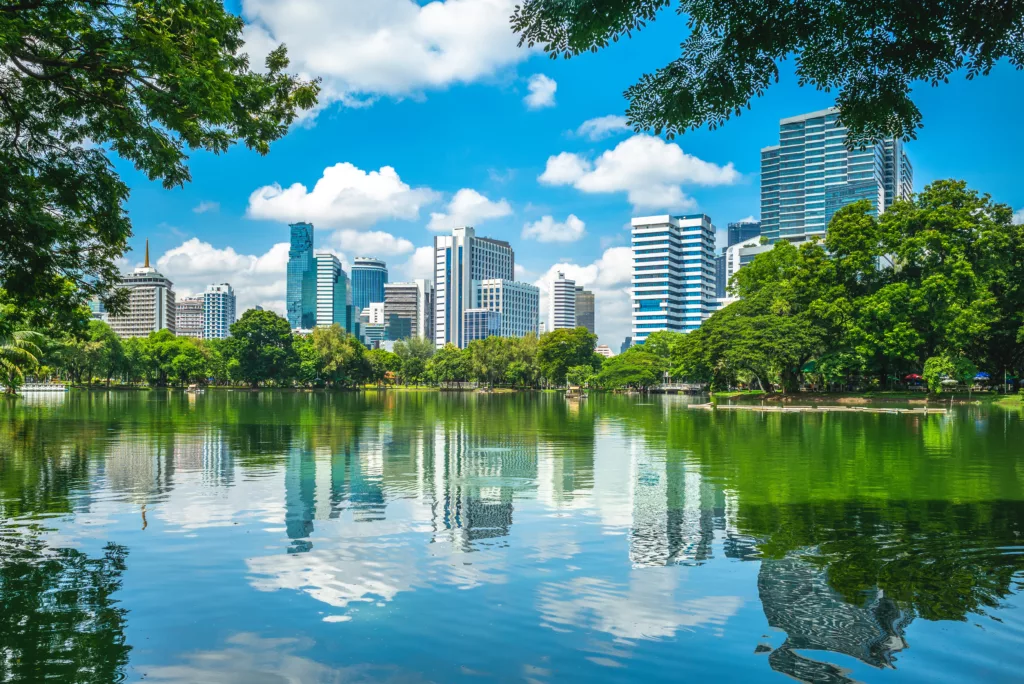
When in need of a break from Bangkok’s vibrant pace, head over to Lumphini Park, the city’s largest green space. Covering an area of 142 acres, this park is a tranquil oasis amidst the bustling metropolis and offers a much-needed breath of fresh air.
Lumphini Park, named after Buddha’s birthplace in Nepal, was originally designed to house Thai crafts and flower displays. The park was created in the 1920s by King Rama VI on royal property and was later opened to the public. Today, it stands as a testament to the city’s commitment to preserving green spaces amidst rapid urban development.
The park is home to various flora and fauna, including a rare sight of water monitor lizards, which, although look intimidating, are harmless. Here’s a fun fact: these creatures can grow up to 2 meters long, making a casual encounter quite an exciting event!
Whether you’re into jogging, cycling, bird-watching, doing yoga, or simply lounging by the lakeside watching paddle boats, Lumphini Park offers a delightful escape from the city’s hustle and bustle. It’s also a popular spot for picnics, open-air concerts, and festivals, making it a hub of community life.
Voyagix Tips
If you’re planning to visit Lumphini Park, here’s some useful information:
- Timing: The park is open every day from 4:30 AM to 9 PM.
- Admission: Entry to the park is free.
- Getting There: The easiest way to reach Lumphini Park is by MRT (Lumphini or Silom station) or BTS (Sala Daeng station).
Lumphini Park offers an invigorating retreat from the intensity of the city. Its lush greenery, serene lake, and diverse activities make it a perfect spot for relaxation and leisurely strolls. So next time you’re in Bangkok and need a breath of fresh air, you know where to go!
8. Visit the Erawan Shrine
In the midst of Bangkok’s modern skyscrapers and bustling shopping districts, the Erawan Shrine offers a spiritual oasis. Known formally as the Thao Maha Phrom Shrine, it is a beloved religious site frequented by locals and tourists alike, providing a fascinating insight into Thailand’s rich spiritual traditions.
The Erawan Shrine was built in 1956 during the construction of the Erawan Hotel to appease supposed superstitious forces that were causing a series of mishaps. The hotel’s construction had been plagued by numerous problems, leading to the belief that spirits were displeased. To appease them, a shrine dedicated to Brahma, the Hindu god of creation often known as Than Tao Mahaprom in Thailand, was built. Interestingly, once the shrine was erected, the problems ceased, and the construction proceeded without a hitch.
Today, the Erawan Shrine is renowned for its golden statue of Brahma, complete with four faces and six arms. It’s believed to bring good fortune, and you’ll often find it surrounded by worshippers offering flowers, incense, and wooden elephants to earn blessings. The Shrine is also famous for its vibrant Thai dance performances, presented by local dance troupes paid by worshippers in return for their prayers being answered.
Voyagix Tips
If you’re planning a visit, here’s some practical information:
- Timing: The Erawan Shrine is open daily from 6 AM to 11 PM.
- Admission: Visiting the shrine is free, but if you want to make merit by hiring the resident Thai dance troupe to perform, there’s a small fee.
- Getting There: The Shrine is conveniently located at the Ratchaprasong intersection, next to the Grand Hyatt Erawan Hotel. The nearest BTS station is Chit Lom.
Visiting the Erawan Shrine allows you to immerse yourself in a spiritual and cultural experience right in the heart of Bangkok’s bustling city center. It’s a testament to the city’s ability to harmoniously blend the ancient with the modern, the spiritual with the everyday.
9. Visit the Art in Paradise Interactive Museum
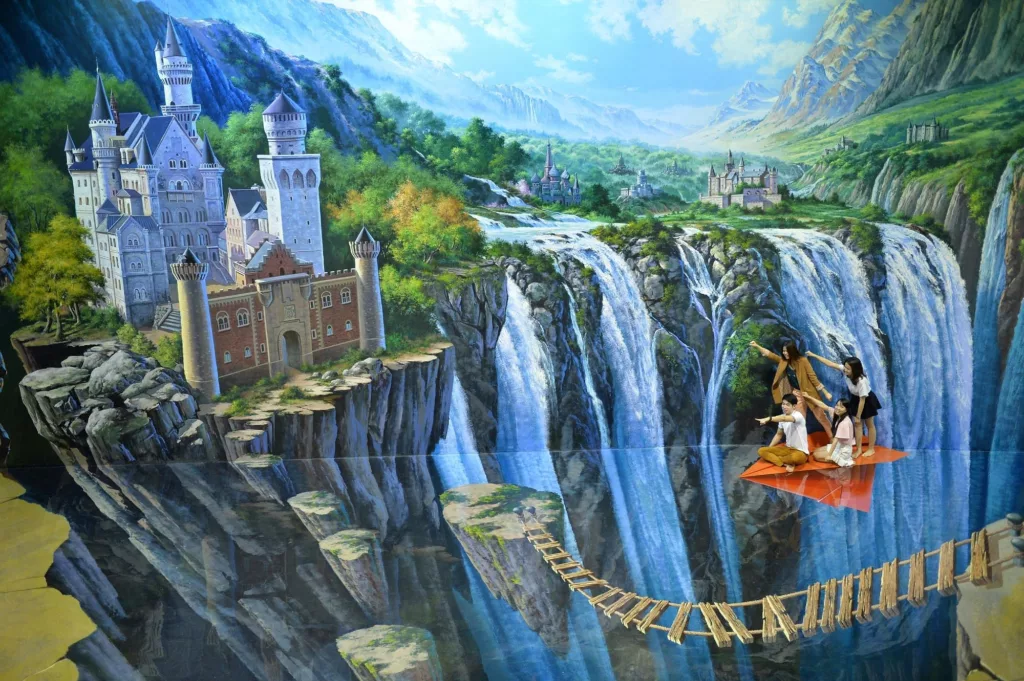
For a fun and unique artistic experience, step into the Art in Paradise interactive museum. This engaging attraction offers a playful introduction to art with its life-sized 3D paintings that invite you to become part of the art itself. This museum is perfect for all ages, making it a fun-filled family experience.
Art in Paradise, also known as the 3D Museum, opened in Bangkok in 2013 following the success of its original branch in Pattaya. It was created by a team of Korean artists who saw an opportunity to bring art to life and make it more interactive and enjoyable for everyone.
The museum is divided into several zones, each offering a distinct theme such as Safari, Aquarium, Classic Art, and Fantasy. In each zone, visitors can interact with the 3D art pieces, creating amusing and creative photographs. The museum’s unique concept has proven to be a hit, with visitors often found striking poses and laughing heartily as they enjoy the interactive exhibits.
Voyagix Tips
If you’re planning to visit, here’s some practical information:
- Timing: The museum is open every day from 10 AM to 10 PM.
- Tickets: The ticket price is 400 THB for adults and 200 THB for children. You can purchase tickets at the venue or through their official website.
- Getting There: The museum is located in Esplanade Shopping Mall on Ratchada road. The nearest MRT station is Thailand Cultural Centre.
Art in Paradise offers a delightful and entertaining break from the traditional museum experience. It’s a place where art comes to life and invites you to step into the picture and become part of the story. Whether you’re an art enthusiast, a photography lover, or simply looking for a fun-filled day in Bangkok, this interactive museum is sure to provide a memorable experience.
10. Explore the Museum of Contemporary Art (MOCA)
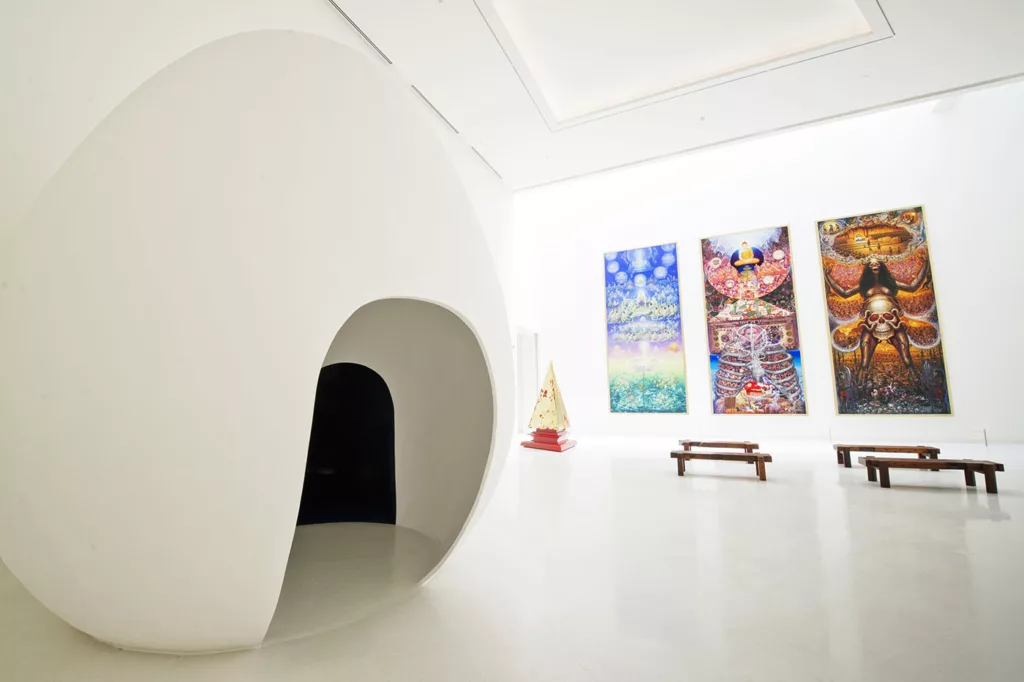
If you’re keen on immersing yourself in Thailand’s dynamic art scene, a visit to the Museum of Contemporary Art (MOCA) is a must. Housing the most comprehensive collection of modern paintings and sculptures in Thailand, MOCA offers a deep dive into the rich tapestry of the country’s artistic expression.
Opened in 2012, the Museum of Contemporary Art is the brainchild of telecommunications magnate Boonchai Bencharongkul. Boonchai built MOCA to celebrate and showcase the works of some of Thailand’s most talented artists and to inspire future generations. The five-story building, with its sleek, modern architecture, offers more than 20,000 square meters of exhibit space.
MOCA features works from renowned Thai artists such as Thawan Duchanee, whose provocative ‘Black House’ in Chiang Rai has garnered international attention. Alongside the contemporary pieces, the museum also houses traditional Thai artwork, presenting a rich dialogue between the past and the present. The museum’s commitment to exhibiting the full spectrum of Thai art makes it a must-visit for art lovers.
Voyagix Tips
If you plan to explore this captivating museum, here’s some practical information:
- Timing: MOCA is open from Tuesday to Sunday, 10 AM to 6 PM. The museum is closed on Mondays.
- Tickets: The entrance fee is 250 THB for adults. Entry is free for children under 15 and seniors over 60.
- Getting There: The museum is located in Chatuchak, a little off the typical tourist path. The easiest way to reach MOCA is by taxi or a combination of BTS (Mo Chit Station) and a short taxi ride.
- Website: For more information, visit the museum’s official website www.mocabangkok.com
A visit to the Museum of Contemporary Art offers a unique opportunity to engage with Thailand’s vibrant and diverse art scene. By showcasing a mix of contemporary and traditional Thai art, MOCA provides a powerful insight into the country’s cultural evolution. It’s a captivating journey that no art lover should miss when in Bangkok.
11. Take a Thai Cooking Class
Embark on a culinary journey and deepen your connection with Thai culture by enrolling in a Thai cooking class. This hands-on experience will teach you how to prepare your favorite Thai dishes, enabling you to bring a taste of Thailand back home with you.
Thai cuisine is celebrated worldwide for its intricate balance of flavors, including spicy, sweet, sour, and salty. While the food is globally renowned, the art of Thai cooking is deeply rooted in the country’s culture and history. A Thai cooking class doesn’t just provide the mechanics of cooking; it also imparts the philosophy behind Thai cuisine, which is largely tied to Buddhist principles, focusing on balance and harmony.
Many cooking classes in Bangkok start with a visit to a local market, where you can learn about Thai ingredients and how to choose the freshest produce. Following this, under the guidance of expert chefs, you’ll learn to create a range of Thai dishes from creamy coconut curries to tangy papaya salad, and the iconic Pad Thai.
Voyagix Tips
If this flavorful journey entices you, here’s some practical information:
- Timing: Most classes last around 3-4 hours and are offered multiple times a day, typically in the morning and afternoon.
- Booking: It’s recommended to book your class in advance. You can do this online through various platforms, or by directly contacting the cooking school.
- Popular Cooking Schools: Some highly-rated schools include Bangkok Thai Cooking Academy and Sompong Thai Cooking School. Always check reviews and compare classes to find the best fit for you.
- Website: Here are the links to the aforementioned schools: Bangkok Thai Cooking Academy and Sompong Thai Cooking School.
A Thai cooking class offers a unique and enjoyable way to immerse yourself in Thai culture. Not only do you get to learn about the ingredients and techniques that make Thai food so delicious, but you also gain a deeper understanding of the culture’s respect for balance and harmony. This experience will leave you with fond memories and a new skill to impress your friends and family back home.
12. Enjoy a Muay Thai Fight
For a pulse-racing, authentic Thai experience, catch a live Muay Thai fight at one of Bangkok’s dedicated stadiums. Known as “the art of eight limbs”, Muay Thai is Thailand’s national sport and a key part of its cultural heritage.
Developed several centuries ago, Muay Thai is a combat sport that utilizes the fists, elbows, knees, and shins, hence its epithet. The sport is more than just a physical contest—it’s steeped in tradition and spiritualism, with fighters performing a ceremonial dance called ‘Wai Khru Ram Muay’ before each bout, to show respect to their teachers and to ask for protection and a fair fight.
There are several stadiums in Bangkok hosting regular fights, but the most popular are Rajadamnern Stadium and Lumpinee Boxing Stadium. These venues offer the chance to witness a thrilling display of athleticism, discipline, and technique, set to the hypnotic rhythm of live traditional Thai music.
Voyagix Tips
If you’re interested in attending a Muay Thai match, here’s some practical information:
- Timing: Fights usually take place on weekdays with the main events often scheduled for the weekends. Start times are usually around 6:30 PM, with events running until late in the evening.
- Tickets: Tickets can be bought at the stadium’s box office on the day of the match, or pre-booked online. Prices vary depending on the location of the seats.
- Website: Check the official websites for Rajadamnern Stadium and Lumpinee Boxing Stadium for fight schedules and ticket information.
Experiencing a live Muay Thai fight is a powerful cultural immersion, offering insight into the discipline, respect, and athleticism inherent in this traditional Thai sport. Whether you’re a martial arts enthusiast or simply looking for a unique and exhilarating night out in Bangkok, a Muay Thai match is a spectacle not to be missed.
13. Visit Khao San Road
Experience the dynamic nightlife of Bangkok by heading over to Khao San Road, a bustling strip renowned for its lively bars, nightclubs, and street food stalls. This place is truly a feast for the senses that perfectly encapsulates the city’s zest for life.
Originally a rice market (hence its name, which translates to ‘Milled Rice’ in English), Khao San Road gradually evolved into a hotspot for budget travelers and backpackers in the 1980s. Today, it’s a thriving mix of cultures and flavors, attracting an international crowd with its exciting nightlife and affordable street food.
Here, you can relish a variety of Thai street food, from the classic Pad Thai to more adventurous dishes like deep-fried insects. The vibrant stalls and restaurants serve food until the early hours of the morning, ensuring that your post-party cravings are well catered for. And when it comes to entertainment, the street’s myriad bars and clubs offer everything from live music to DJ sets, so you can dance the night away.
Voyagix Tips
For those planning to experience the exhilarating nightlife of Khao San Road, here are some useful tips:
- Timing: Khao San Road is active throughout the day, but it truly comes alive after sunset, often staying vibrant until 2-3 AM.
- Getting There: It’s located in the Banglamphu area of Bangkok. You can get there by taxi, tuk-tuk, or even a riverboat that stops near Phra Arthit Pier.
Experiencing the energy and vibrancy of Khao San Road is a must for anyone seeking a taste of Bangkok’s exciting nightlife. From the plethora of tantalizing street food to the pulsating music emanating from the bars, it provides a sensory delight that perfectly captures the spirit of this incredible city.
14. Try a Traditional Thai Massage
A trip to Bangkok wouldn’t be complete without indulging in a rejuvenating traditional Thai massage. Known as ‘nuat phaen boran’ in Thai (which translates to ‘ancient’ or ‘traditional’ massage), Thai massage is a centuries-old practice that aims to restore balance and harmony in the body, helping to relieve travel fatigue and tension.
Originating from the time of Buddha, Thai massage is an integral part of traditional Thai medicine. It combines acupressure, assisted yoga postures, and Ayurvedic principles to provide a holistic healing experience. In 2019, the art of Thai massage was added to UNESCO’s Intangible Cultural Heritage of Humanity list, highlighting its significance and value.
During a Thai massage session, practitioners use their hands, knees, legs, and feet to move you into a series of yoga-like stretches. Expect to be twisted, pulled, and rocked in order to clear energy blockages and relieve tension. Thai massage also involves deep, rhythmic pressing that helps to soothe muscles and promote relaxation.
Voyagix Tips
If you’re keen to experience this authentic Thai wellness tradition, here’s some practical information:
- Booking: You can walk into many massage parlors for a session, but it’s recommended to book ahead, especially at popular spas.
- Popular Locations: Wat Pho Traditional Medical School, known as the birthplace of Thai massage, and Health Land Spa are two renowned places to get a Thai massage in Bangkok.
- Website: Check out the official websites of Wat Pho Traditional Medical School and Health Land Spa for more information and to make bookings.
Immersing yourself in the experience of a traditional Thai massage is not only a great way to relieve travel fatigue but also an opportunity to engage with Thailand’s rich cultural heritage. After your massage, you’re likely to feel revitalized and ready to explore more of what this fantastic city has to offer.
15. Visit the Rot Fai Night Market
Capping off your Bangkok adventure, make sure to pay a visit to the Rot Fai Night Market, also known as the Train Market. It’s a one-of-a-kind shopping experience, famous for its eclectic mix of vintage items, delicious street food, and local handicrafts.
The Rot Fai Night Market originally started in the Chatuchak area but had to relocate due to its growing size. Today, it’s found in the Srinakarin Soi 51 area, behind Seacon Square Shopping Mall, and has become a haven for antique lovers and bargain hunters alike.
Wandering through the market’s labyrinthine lanes, you’ll come across a fascinating variety of stalls selling everything from retro furniture and classic cars to vinyl records and vintage clothing. In addition to the main market, there are three sections: ‘Market Zone’, ‘Warehouse Zone’, and ‘Rod’s Antiques’ – each providing its own unique shopping experience.
Once you’ve worked up an appetite exploring the stalls, be sure to sample the market’s array of Thai street food. There are numerous food stalls and bars where you can enjoy local delicacies and a cold drink.
Voyagix Tips
For those interested in experiencing the vibrant Rot Fai Night Market, here’s some helpful information:
- Timing: The market operates from Thursday to Sunday, opening in the late afternoon at around 5 PM and continuing until past midnight.
- Getting There: The market is located quite far out from the city center. You can take a taxi or a bus to reach there. If you’re adventurous, consider taking a motorcycle taxi from the On Nut BTS station.
The Rot Fai Night Market offers a truly unique and rewarding way to spend an evening in Bangkok. Not only can you discover unique vintage treasures and enjoy local food, but you can also immerse yourself in the authentic, bustling atmosphere that this night market so richly provides.
Conclusion
As our guide comes to a close, it’s clear that Bangkok is a city bursting with experiences just waiting to discover. It’s a city where each moment spent offers a unique snapshot into its intricate fabric of culture, history, and modernity. As you journey through the streets of Bangkok, taking in the captivating blend of sights, sounds, and tastes, you’ll come to realize that these 15 things to do are not just mere activities, but rather profound experiences that deeply immerse you into the heart and soul of this remarkable city.
But remember, these 15 unforgettable things to do in Bangkok are just a starting point to your exploration. The city’s unique mix of ancient culture and modern dynamism creates a captivating blend of experiences that is sure to make your trip one for the books. Whether it’s your first visit or your tenth, Bangkok always has something new to offer. It’s a city that continues to evolve, yet remains deeply rooted in its rich heritage. As you embark on your adventure, know that you’re not merely visiting a destination, but entering a world that is sure to amaze, inspire, and create memories that will last a lifetime. Enjoy your adventure!

